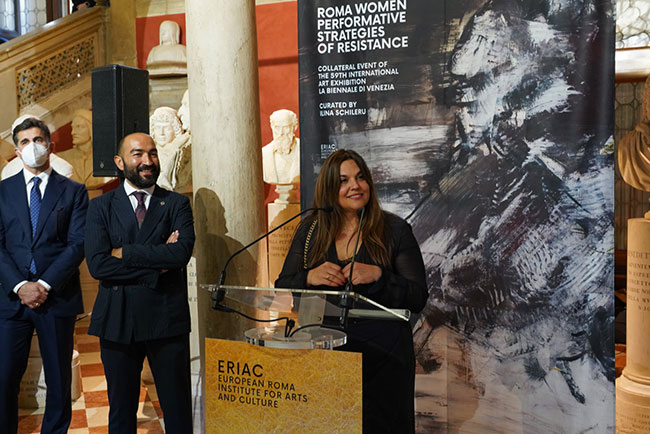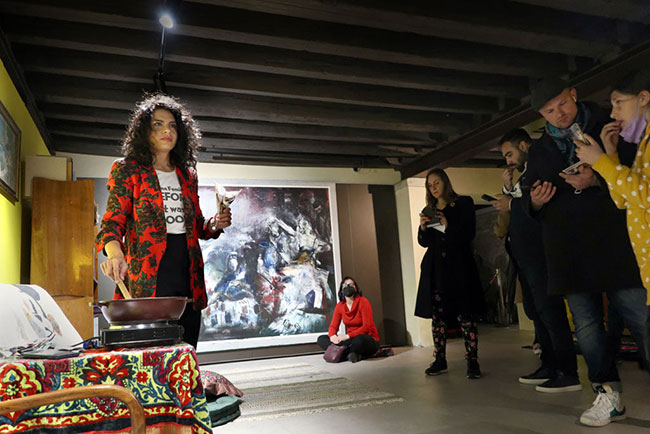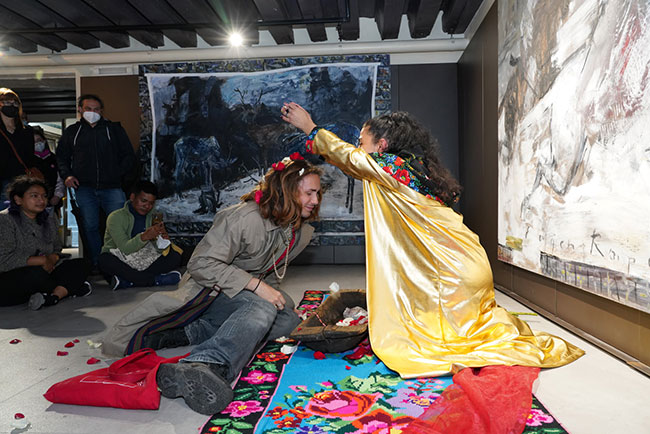Zeljko Jovanovic: This year’s success is just the beginning, Romani culture at the Venice Biennale transcends national borders
Eugen Raportoru and his portray at the exhibition (2022 Venice Biennale) (Photograph: ERIAC)
This year’s Venice Biennale is a terrific moment for Romani society. The exhibition of Romani artist Małgorzata Mirgy-Tas in the Polish pavilion is not the only case in point, either.
In the metropolis heart, an exhibition by the renowned Romani painter Eugen Raportoru is also taking location in a palace dating to the 15th century, surrounded by the waters of the Venetian canals. “This year, anything incredible has occurred,” Zejlko Jovanovic, director of the Open up Society Foundation’s Roma Initiatives Business office and chair of the Board of Directors of the European Roma Institute for Artwork and Lifestyle (ERIAC) claimed at the grand opening of the exhibition, who, along with ERIAC Government Director Timea Junghaus, is a person of its commissioners.
“If you consider in it, each exertion will manifest results. Our participation in the Biennale is a guarantee, inspite of all that is taking place now with the war in Ukraine and the risk of nuclear conflict,” Jovanovic said.
In accordance to Junghaus, Romani lifestyle is excellent exactly since it transcends nationwide borders and phone calls for multinational participation. On the other hand, in the extended background of the Biennale given that its opening in 1895, this is just the fourth time Romani artists have been provided space there.

Commissioners of the exhibition Zeljko Jovanovic and Timea Junghaus at the ceremonial opening of “The Abduction from the Seraglio” at the Loredan Palace (Photograph: ERIAC)
The to start with time was in 2007, when an exhibition of present-day Romani artists known as “Paradise Missing” took spot at the Biennale. This year’s exhibition entitled “Abduction from Seraiglio” is the outcome of collaboration amongst Eugen Raportoru, a 60-year-outdated male Romanian painter of Roma descent, and activists who are woman, Roma, and nicely-recognised from the younger era, these kinds of as the award-winning actor, director and screenwriter Alina Serban and the gifted, functional artist and founder of the Giuvlipen Theater Organization in Bucharest, Mihaela Dragan.
The total exhibition is conceived as the inside of Eugen’s childhood house in the 1960s and 1970s, whereby his significant-structure paintings are his very own interpretation of the tapestries that utilized to be a recurrent decoration of household interiors in Romania. Earlier mentioned a double bed with a colorful bedspread hang the tapestries that adorned the painter’s childhood home.
The matter of these tapestries, after Wolfgang Amadeus Mozart’s singspiel, was “The Abduction from the Seraglio”, just after which the exhibition is named. Earlier mentioned them is a photograph of “The Final Supper” immediately after the original by Leonardo da Vinci.
“An picture of ‘The Last Supper’ is rather routinely a element of home decoration in Romania,” says the young curator of the exhibition, Ilina Schileru, who is not Roma herself. “In point, it was interesting for me to find out how significantly the Roma houses in Romania resemble the non-Roma types. Persons in our country really like this photograph, and frequently they do not even know who painted it. It is a image of religion and togetherness, a evening meal in which many individuals come jointly.”

Alina Serban doing in the exhibition “The Abduction from the Seraglio”(Picture: ERIAC)
Most of the exhibition’s gear and props had been mentioned to have been located in flea markets by the artists. These include books, an outdated turntable, paintings, period of time household furniture, photographs and porcelain.
The curator 1st received to know Raportoru for the duration of her studies at Bucharest’s National University of Artwork. She had just graduated from high school and Eugen was 45 several years outdated when, as an by now renowned artist, he resolved to insert to his artistic education and learning by enrolling there.
Immediately after Raporturu approached Shileru to collaborate on this year’s Biennale, their thoughts joined forces in an interesting undertaking that issues viewers to demolish prejudice and completely transform their mindsets as a result of art and creative imagination. Dragan and Serban then complete feminist voices in a section of the challenge that resonates with the subject areas of this year’s Biennale.
“I agreed with Eugen that we would invite famed gals and give them free of charge rein. It is completely up to them how they enrich the exhibition,” mentioned the youthful curator.

Mihaela Dragan presents blessings with flower petals in the exhibition “The Abduction from the Seraglio” (Photograph: ERIAC)
Dragan and Serban break down stereotypes through their performances without ever offering up on what tends to make Romani culture unique. Dragan, dressed in distinct clothing, speaks her lines in verse.
She walks by the props: Crystal balls for fortune-telling and tarot playing cards, incense and roses. She speaks about discrimination, the marginalizing and stereotyping of Roma, the sexualization of Romani women.
Dragan invests her verses with her belief that one particular can adjust one’s destiny, calling for therapeutic and enjoy. She emphasizes the power of ladies and speaks to them.
“Increase up girls, all females increase up,” she recites. In the next room, Alina Serban gives out paper cones whole of sunflower seeds to the visitors.
The seeds are a reminder of a story about her mothers and fathers, a person marked by prejudice and racism. “You’re fortunate to have a bastard in your belly. Normally, I would jump on you with my boots on,” she rates a police officer saying harshly to her expecting mom when she was promoting sunflower seeds.
“For me, sunflower seeds suggest the neighborhood. Safety. However, the Romani neighborhood is perceived from the outdoors as uneducated. So I invite you now: Be uneducated with me,” Alina says to the site visitors, drawing the viewers into her entire world and offering cones comprehensive of seeds as a image of solidarity.
“The Abduction from the Seraglio” opened on 22 April, and on that event lots of important figures and journalists satisfied in the entrance corridor of the Loredan Palace. Between them were being Dijana Pavlovic, an activist and politician dwelling in Rome Ioanida Costache, a filmmaker, violinist and writer and the activist and American college professor of Romani origin Ethel Brooks, all of whom then contributed to the exhibition with their very own performances.
In his speech, Jovanovic expressed his hope that Romani persons will be capable to get their own lasting space at the Biennale in the potential. “This yr we are going through an outstanding problem,” he said.
“Nonetheless, it is essential to split down this dogma that only people today who have their possess point out can have their have pavilion. We are not performed,” he explained.
“This year’s victory is just the commencing,” Jovanovic advised the exhibition people. Speaking to Romea.cz, artist Eugen Raportoru stated: “We have a large amount of skills and we have a lot to convey to the planet through our art. We need to have to be observed, we need to have assist, and we will need people today to comprehend who we are.”

